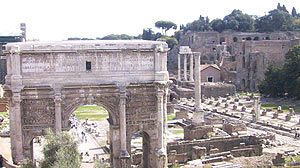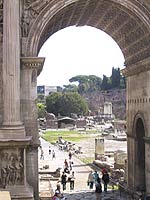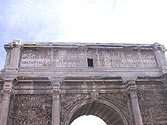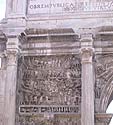| "THE
SEVERI'S HISTORY"

SETTIMIO
SEVERO' ARCH |
Settimio
Severo was the first of Severi's dinasty that would have not left
a great sign on the Rome's destiny. Settimo Severo was in fact
a general who bought the throne after the death of Commodo, Marco
Aurelio's son, happened in 192 A.D.After Commodo's murder both
population and Senatus wanted an upright person who was found
in Pertinace. The choice was right at the point that pretoriani
(imperial guard created by Augusto) killed him after just 83 days
of good government and put up for auction the title. Didio Giuliano,
a rich banker, won offering 6250 dracme to any pretoriano. Senatus
strongly opposed to this auction and called general Settimio Severo
who came with his legions to restore the order. The guards offered
the Didio's head and Pertinace's murderers to Settimio who pretended
to accept but later cancelled the imperial guard ordering to any
of them to live at least 100 km far from Rome.
He was born in Leptis Magna in Africa and made his cursus honorum
in many provinces of the empire (Sardegna, Spain, Gallia and Syria
where met his second wife Giulia Domna, a beautiful and unscrupulous
women who gave him 2 sons, Caracalla and Geta). After his election,
some eastern provinces sided with Pescennio Nigro so that Severo
immediately had to fight for the power just received. Two battles
fought close to Nicea gave to Severo a good advantage and after
1 year he finally won and acted his revenge against all the populations
that gave support to Porscennio: Parthian above all and Osroenian.
Bisanzio resisted three years to the siege. Severo spent then
some years in Britannia where governor Clodio Albino declared
himself Augusto and marched toward Rome. Severo went to Gallia
where the battle took place in Saˇne valley the 19th of February
197 A.D.  and
won after a long resistence by Albino, who killed himself with
his sword. Severo cut his head and sent it to the Senatus that
after all always supported Albino. Later in Rome processed more
than 60 senators and executed 29 of them, restored Commodo's cult
and put to death his murderer. This was Settimio Severo, first
emperor of Severi's dinasty. In the same time Vologese IV, Parthian's
king, had invaded Mesopotamia obliging Severo to one more trip
in eastern province. This time the battle was easily won by Severo
who occupied again Mesopotamia and plundered the capital of Parthian.
Coming back to Rome this soldier decided to besiege Atra for 20
days but its inhabitants resisted and obliged Severo to give up. and
won after a long resistence by Albino, who killed himself with
his sword. Severo cut his head and sent it to the Senatus that
after all always supported Albino. Later in Rome processed more
than 60 senators and executed 29 of them, restored Commodo's cult
and put to death his murderer. This was Settimio Severo, first
emperor of Severi's dinasty. In the same time Vologese IV, Parthian's
king, had invaded Mesopotamia obliging Severo to one more trip
in eastern province. This time the battle was easily won by Severo
who occupied again Mesopotamia and plundered the capital of Parthian.
Coming back to Rome this soldier decided to besiege Atra for 20
days but its inhabitants resisted and obliged Severo to give up.
Settimio Severo's Arch was erected 4 years later in the Roman
Forum to commemorate the war against and the Parthian, Osroeni
and the first 10 years of his empire dedicated entirely to fight
with Senatus, governor Albino, Parthian and to give always more
money and power to his soldiers. Severo was so convinced that
having the army on his side he would have never had nothing to
be afraid that suggested to his 2 sons this rule when in 211 A.D.
died in Britannia where he went to fight his last battle. Caracalla,
whose real name was Bassiano Antonino, ordered to kill his brother
Geta and more than 20.000 Romans suspected to be on his brother's
side, went on with the policy of paying the soldiers always more
and reduced the power of Senatus. Nowadays it's still possible
to see on the inscription on the upper part of the arch the holes
of the bronze letters where Severo remembered his son Geta, later
cancelled by Caracalla (the fifth line was changed. once it read:
P. Septimio L. fil Getae nobilissi(mo)
meaning "to the most noble Geta, son of Lucius Septimius,
Publius Septimius). Caracalla linked his name to the erection
of huge thermal baths still visible today but surely he was not
an intelligent emperor loving more the games at Coliseum of which
he was not just witness. Many people think that good things he
made during his empire have to be given to his intelligent mother
Giulia Domna. Caracalla later went to Renia, Egypt, Parthia demonstrating
to be fascinated by Alessandro Magno's mith and behaving in the
style of Achille; he continually started new wars till the day
he was murdered by his guards in april 217 A.D.
"THE
ARCH and its bas-reliefs"
| CLICK
IMAGES TO ENLARGE THEM |
 UPPER
PART
UPPER
PART |
 3rd
PANEL
3rd
PANEL |
 VIEW
VIEW |
Severo's
Arch stands in the middle of the Via Sacra that crosses the Roman
Forum leading to the Capitolium Hill. It's well preserved even
if in medieval times it was used as barber's shop. The bas-reliefs
placed above lateral arches show scenes from the wars in Parthia.
They have to be read starting on the left side towards the Forum
Romanum and moving rightward around the arch. Each bas-relief
are read from the bottom to the up and divided in two or three
scenes.
First panel, not well kept, shows the preparations for
war; the middle battle scenes between Romans and Parthians; and
the emperor, on the left, talking to the soldiers and the liberation
of a besieged city with the flight of Vologese IV, Parthian's
king;
Second panel shows scenes from the war against the Osroeni:
the lower shows the Roman army attacking Edessa with war machines;
the middle register shows Septimius Severus talking to the troops,
and the surrender of king Osroenian Abgar to the emperor; the
upper register shows the emperor in charge of operations and a
war council in a fortified camp.
Third panel (to the left on the Capitol side) has two registers.
The lower shows the attack on the city of Seleucia on the River
Tigris, with the Parthians fleeing on horseback towards the right;
and above the Parthians surrendering to the emperor and his entry
into Seleucia.
Fourth panel shows, in two registers, a besieged Ctesiphon,
Parthians' capital, with war machines, and the flight of the defeated
enemy king; above is represented Severo speaking to the victorious
armies in front of the conquered city. |